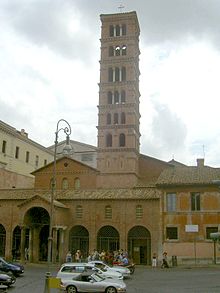Santa Maria in Cosmedin
| Basilica of Saint Mary in Cosmedin Basilica di Santa Maria in Cosmedin (Italian) |
|
|---|---|

Medieval façade of Santa Maria in Cosmedin, with the bell tower.
|
|
| Basic information | |
| Location | Rome, Italy |
| Geographic coordinates | 41°53′17″N 12°28′54″E / 41.88806°N 12.48167°ECoordinates: 41°53′17″N 12°28′54″E / 41.88806°N 12.48167°E |
| Affiliation | Roman Catholic |
| Rite | Greek-Melkite Rite, Latin Rite |
| Ecclesiastical or organizational status | Minor basilica |
| Leadership | Msgr. Antonio Riccardo Menegaldo |
| Website | Official Website |
| Architectural description | |
| Architectural type | Church |
| Completed | 11th century |
| Specifications | |
| Direction of façade | Northwest |
| Length | 40 metres (130 ft) |
| Width | 20 metres (66 ft) |
| Width (nave) | 10 metres (33 ft) |
The Basilica of Saint Mary in Cosmedin (Italian: Basilica di Santa Maria in Cosmedin or de Schola Graeca) is a minor basilica church in Rome, Italy. It is located in the rione of Ripa.
The church was built in the 8th century, during the Byzantine Papacy, over the remains of the Templum Herculis Pompeiani in the Forum Boarium and of the Statio annonae, one of the food distribution centres of ancient Rome (another is to be found at the Theatre of Balbus). A deaconry was a place where charitable distributions were given to the poor, and it is appropriate that such an institution would have been built near or at a station of the Roman annona.
Since it was located near many Byzantine structures, in 7th century this church was called de Schola Graeca, and a close street is still called della Greca. Greek monks escaping iconoclastic persecutions decorated the church around 782, when pope Adrian I promoted its reconstruction; the church was built with a nave and two aisles and a portico. Because of its beauty, the church received the adjective cosmedin (from Greek kosmidion), ornate. A sacristy and an oratory dedicated to St. Nicholas were added in the 9th century, by order of Pope Nicholas I, who also built a papal residence, but they were destroyed in the Sack of Rome (1084) by Robert Guiscard's Norman troops.
...
Wikipedia
